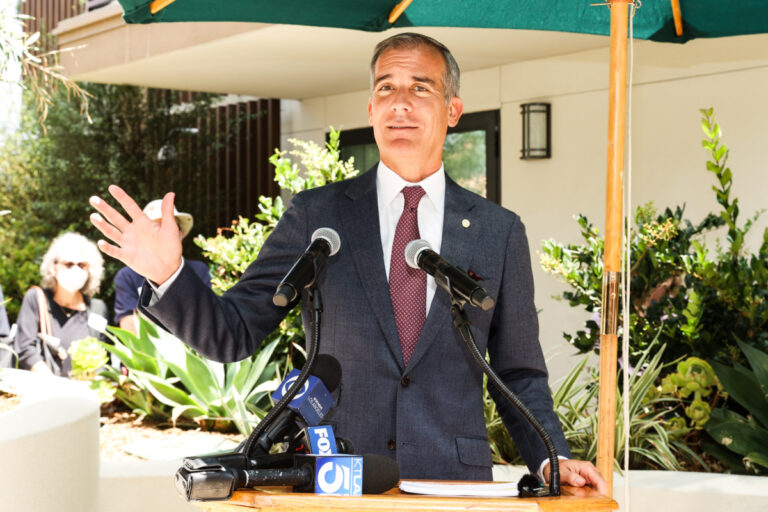
July 26 saw the opening of the 74-unit Missouri Place, a new supportive housing facility in West Los Angeles created by Thomas Safran & Associates, with Mayor Eric Garcetti, Councilmember Mike Bonin, and Assembly Person Richard Bloom among the civic leaders in attendance.
“At the Housing Department, we are excited to see yet another HHH-funded project completed and readied for servicing L.A.’s unhoused neighbors,” Ann Sewill, general manager, city of Los Angeles Housing Department, said in a statement. “The Missouri Place building is one of 125 projects in the HHH pipeline, which is a massive effort that contributes towards the solutions to end homelessness in Los Angeles.”
While there’s reason to celebrate the opening of Missouri Place, which will help homeless people transition to a normalized living situation, there’s been a good dose of criticism of the city-financed program that helped Missouri Place get built.
It’s been six years since Angelenos passed Proposition HHH, a $1.2 billion bond devoted to creating 10,000 units of supportive housing, and some believe too little has been accomplished – and it has come at a high cost. The number of units built will be closer to 8,000.
Los Angeles Controller Ron Galperin is one of the doubters.
“Although Los Angeles has made some progress with Proposition HHH, it hasn’t been enough,” Galperin said in a statement in February. “The costs are too high and the pace is too slow to address the tragedy on our streets.”
According to Galperin’s report, HHH projects are taking between three and six years to complete. At the current pace, 54% of all units will not open for another two to four years. Even when every HHH unit is built, tens of thousands of Angelenos will still lack housing.
Of the 8,091 total HHH housing units to be produced across 125 projects, only 1,142 units (14%) are ready for occupancy today, 4,347 units (54%) are under construction and 2,602 units (32%) are in pre-development, according to Galperin’s data.
HHH costs have reached staggering heights. For projects in construction, the average per-unit cost jumped to almost $600,000 last year — up from $530,000 the previous year. Another 14% of units in construction cost more than $700,000 each. One project in pre-development is estimated to cost $837,000 a unit — nearly $100,000 per unit more than the most expensive project of 2020.
Reason for costs
Mark Oberholzer of downtown L.A. architecture firm KTGY has worked on HHH-funded projects spearheaded by both nonprofits and private investors. He sees why it’s often more expensive to create affordable housing than market-rate housing.
“There’s not some sort of incompetence going on,” he said of HHH. “There’s a very complex ecosystem.”
The high costs of a supportive housing project begins with more expensive labor.
“Everyone gets prevailing wage,” Oberholzer said. “But the market-rate apartment building is not paying the same labor rates.”
Also slowing up the pace is the bureaucracy and the level of accessibility that building supportive housing entails.
“There’s not a complete clarity of the rules,” Oberholzer said. “There’s federal accessibility guidelines. There’s California building code. There’s an added layer of accessibility required for these projects. Unfortunately, it’s determined by case law. Los Angeles in general has some added problems. There was a lawsuit in the last 10 years and because of that there’s another layer of accessibility standards.
“The biggest developer of affordable housing are nonprofits,” Oberholzer added. “Originally HHH was only for nonprofits. Some of it was carved out for private capital.”
“We have to pay prevailing wages, which is 20 or 25% more than market wages,” said Joel John Roberts, chief executive of Path Ventures, which has 19 supportive housing developments under construction and 19 in the pipeline — the majority in Los Angeles.
Last year, the 122-unit Path Metro Villas, Phase II in Silver Lake was completed. It was the first project to receive HHH funding.
Covid slowdown
The pandemic added an element of chaos to the project.
“This was in the middle of Covid,” Roberts said. “We had construction workers catching Covid. We had less inspectors to come on-site.”
There are also the financing fees such as the cost of loans for land and construction and permanent loans. And the public-sector fees — plan check, permit and utility connection.
“We have to layer all those funds: federal, state, city. If they put all of the funding all together in one package, that would save us a year,” Roberts said. “Everyone has different timelines, different rules. The market-rate people don’t have to do that.”
Roberts said his organization is at a disadvantage compared to the well-heeled private developer.
Path Ventures did an internal study and found a 29% difference between the $504,000 per-unit cost of creating housing in the public sector and the $357,840 per-unit cost at market rate.
Recommendations
In his report, Galperin has made a series of recommendations that include speeding up the city review processes for HHH-funded projects and acquiring and converting existing buildings for housing. Galperin would also like to build interim housing and facilities using HHH funds.
Jordan Pynes, president of Thomas Safran & Associates, agrees that the process could be streamlined.
“Putting the financing on these projects have made it difficult,” Pynes said. “You have to go to multiple sources to get these buildings financed. Even with the land donated.”
